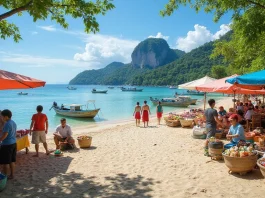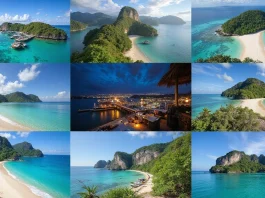A Traveler’s Guide to Traditional Festivals in Asia
Japan’s Mesmerizing Festivals
Cherry Blossom Festivals (Hanami)
Cherry blossom festivals, known locally as Hanami, are synonymous with Japan and symbolize the transient beauty of life. These festivals occur in spring, usually from late March to early April, as cherry blossoms blanket the country in a pink hue. Popular locations include Tokyo's Ueno Park, Kyoto's Philosopher's Path, and Osaka Castle Park. Visitors can partake in picnics under the cherry blossoms, enjoy traditional tea ceremonies, and experience cultural performances.
Gion Matsuri
Held in Kyoto every July, Gion Matsuri is one of Japan’s most famous festivals, dating back over a thousand years. The festival was originally established as a religious ceremony to appease the gods during a plague. Today, it draws massive crowds with its grand parades of floats, known as yamaboko, and traditional music. Participating in the evening Yoiyama, where the streets are decorated with lanterns and lined with food stalls, offers a truly mesmerizing experience.
China’s Cultural Extravaganzas
Chinese New Year
Celebrated around late January or early February, Chinese New Year marks the beginning of the lunar calendar. It is characterized by vibrant parades, dragon and lion dances, and fireworks. Families come together for reunion dinners, and the color red dominates as a symbol of good luck. Beijing and Shanghai host some of the most spectacular celebrations, but experiencing the festival in smaller towns offers a more authentic and intimate insight into the traditions.
Mid-Autumn Festival
The Mid-Autumn Festival, also known as the Moon Festival, takes place on the 15th day of the eighth lunar month. It’s an occasion for families to gather, eat mooncakes, and admire the full moon. Lantern displays are also a significant part of the festivities. In cities like Hong Kong, Guangzhou, and Hangzhou, large public celebrations featuring dragon dances and lantern carnivals are held, drawing both locals and tourists alike.
India’s Colorful Celebrations
Diwali
Known as the Festival of Lights, Diwali is celebrated in October or November. This five-day festival signifies the triumph of light over darkness and good over evil. Homes are adorned with oil lamps, candles, and colorful rangolis. Fireworks light up the sky, and sweet treats are shared among family and friends. Major cities like Delhi, Mumbai, and Jaipur offer breathtaking scenes during Diwali, with magnificent light displays and engaging cultural performances.
Holi
Holi, the festival of colors, takes place in March across India. It marks the arrival of spring and celebrates the victory of good over evil. Participants throw vibrant colored powders at each other, creating a joyous and chaotic spectacle. Various regions celebrate Holi in uniquely vibrant ways, such as Lathmar Holi in Uttar Pradesh, where women playfully hit men with sticks, and the traditional Holi celebrations in Rajasthan’s Jaipur and Udaipur, which include royal processions.
Thailand’s Vibrant Festivities
Loy Krathong
Loy Krathong is celebrated on the full moon night of the twelfth lunar month, usually in November. Participants release beautifully decorated baskets, or krathongs, onto rivers and lakes while making wishes. This festival is a time to show gratitude to the water goddess and seek forgiveness for past misdeeds. Chiang Mai and Sukhothai host some of the most spectacular Loy Krathong celebrations, with traditional dance performances and illuminated displays.
Songkran Festival
Songkran, the Thai New Year, held from April 13th to 15th, is famous for its water fights. This festival doubles as a water purification ritual and a celebration of renewal and goodwill. People joyfully splash water on each other, representing the washing away of sins and bad luck. Besides the joyous water battles in cities like Bangkok and Chiang Mai, visitors can enjoy cultural parades and temple ceremonies highlighting Thai traditions.
South Korea’s Unique Traditions
Chuseok
Chuseok, often compared to Thanksgiving, is a major harvest festival celebrated in late September or early October. Families pay respects to their ancestors with specially prepared foods, while giving thanks for the harvest. Traditional games, dances like “ganggangsullae,” and wearing of hanbok (traditional clothing) are key highlights. In Seoul and Busan, tourists can participate in public events and enjoy sampling traditional Chuseok delicacies like songpyeon (rice cakes).
Boryeong Mud Festival
While not a traditional festival in the historic sense, the Boryeong Mud Festival has gained popularity for its unique and playful activities. Held every July in Boryeong, participants indulge in mud wrestling, mud slides, and mud painting on Daecheon Beach. Originally started to promote the area’s mud cosmetic products, the festival has grown into an international attraction, offering a fun-filled cultural exchange and a chance to enjoy the therapeutic benefits of the mud.
Vietnam’s Traditional Celebrations
Tet Nguyen Dan (Lunar New Year)
Tet is the most important celebration in Vietnam, marking the beginning of the lunar new year. It usually falls in late January or early February and is a time for family reunions, ancestral worship, and renewal of personal relationships. The streets are decorated with peach blossoms, kumquat trees, and red lanterns. Cities like Hanoi and Ho Chi Minh City become vibrant with parades, fireworks, and traditional music performances, where visitors can join the joyous festive spirit.
Mid-Autumn Festival (Tet Trung Thu)
Celebrated on the 15th day of the eighth lunar month, the Mid-Autumn Festival in Vietnam focuses on children and family reunions. Children carry colorful lanterns and participate in lion dances, while families enjoy mooncakes and fruits arranged in the shape of animals. Hanoi and Hoi An are great places to experience the festival, where lively public celebrations and lantern parades create a delightful ambiance for both locals and visitors.
Indonesia’s Rich Festive Heritage
Nyepi Day
Nyepi, also known as the Day of Silence, is celebrated in Bali to mark the Balinese New Year. Unlike typical festivals, Nyepi involves a day of total silence, fasting, and meditation. On the eve of Nyepi, large and colorful ogoh-ogoh (demonic statues) parades take place, symbolizing the cleansing of negative influences. The following day, the entire island shuts down for self-reflection and reconnecting with nature. It’s a unique experience for travelers seeking tranquility and cultural insight.
Ramayana Ballet at Prambanan
Though not a festival in itself, the Ramayana Ballet performed at Prambanan Temple is a cultural showcase that should not be missed. This traditional dance-drama depicts the story of Prince Rama and his struggle to rescue his wife Sita. Held from May to October, the performances take place against the backdrop of the illuminated Prambanan Temple, offering a visually enchanting experience that celebrates Indonesia's rich artistic traditions.
Malaysia’s Multicultural Festivities
Hari Raya Aidilfitri
Following the month of Ramadan, Hari Raya Aidilfitri is celebrated by Muslims across Malaysia. It marks the end of fasting and is a time for forgiveness, feasting, and festive open houses. Traditional Malaysian dishes like rendang, ketupat, and satay are served, and homes are decorated with oil lamps and colorful lights. Cities such as Kuala Lumpur and Penang offer a glimpse into the diverse cultural tapestry through lively gatherings and public celebrations.
Thaipusam
Thaipusam is a Hindu festival predominantly celebrated by the Tamil community. It takes places in January or February and honors the deity Lord Murugan. Devotees undertake a pilgrimage to Batu Caves in Kuala Lumpur, carrying kavadis adorned with peacock feathers and piercing their skin as acts of devotion. The festival is a grand spectacle of faith and endurance, offering travelers an intense and vibrant insight into the spiritual practices of Malaysia's Hindu community.
Philippines’ Diverse Celebrations
Sinulog Festival
Held every third Sunday of January in Cebu City, the Sinulog Festival pays homage to the Santo Niño, or the Child Jesus. This week-long celebration features street parades with colorful costumes, street dancing, and traditional music. The festival's highlight is a grand parade along Cebu's major streets with participants dancing to the rhythmic beat of drums, providing visitors with an exhilarating cultural experience.
Ati-Atihan Festival
Celebrated in Kalibo, Aklan, every January, the Ati-Atihan Festival honors the indigenous Ati people and the Santo Niño. Participants paint their faces with black soot and don tribal costumes to dance through the streets. Known as the “Mother of All Philippine Festivals,” Ati-Atihan provides an inclusive and lively atmosphere with its music, dance, and community gathering, offering an immersive look into Filipino culture and traditions.
Festivals in Other Notable Asian Countries
Nepal’s Tihar (Festival of Lights)
Tihar, a five-day Hindu festival similar to Diwali, takes place in October or November. Each day is dedicated to different animals such as crows, dogs, and cows, and concludes with Bhai Tika, a celebration of the bond between brothers and sisters. The festival is marked by lighting oil lamps, creating colorful rangolis, and indulging in traditional sweets. Kathmandu becomes particularly vibrant, with cultural performances and markets bustling with festive activity.
Bhutan’s Paro Tsechu
Held in the spring, Paro Tsechu is a major religious festival in Bhutan, honoring Guru Rinpoche, who introduced Buddhism to Bhutan. People from all walks of life gather to witness masked dance-dramas performed by monks. The festival is characterized by vivid colors, intricate costumes, and the unveiling of a giant thangka (Buddhist painting) on the final day. The festive air and spiritual zeal make Paro Tsechu a captivating experience for travelers seeking to understand Bhutanese culture.
Conclusion of Explorations
While each festival in Asia is distinctive, representing the rich tapestry of cultural practices and traditions, they all share a common thread of bringing communities together and offering visitors a deeper insight into the diverse heritage that defines this vibrant continent. Exploring these traditional festivals allows travelers not only to witness the creativity and devotion of the local people but also to participate in the joyous and spiritual experiences that have been cherished for centuries.




